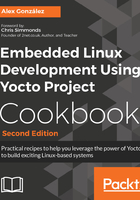
Conventions used
There are a number of text conventions used throughout this book.
CodeInText: Indicates code words in text, database table names, folder names, filenames, file extensions, pathnames, dummy URLs, user input, and Twitter handles. Here is an example: "In this case, both imx6q.dtsi and ;imx6qdl-wandboard-revd1.dtsi are overlaid with the contents of imx6qp-wandboard-revd1.dts."
A block of code is set as follows:
#include "imx6q-wandboard-revd1.dts"
#include "imx6qp.dtsi"
/ {
model = "Wandboard i.MX6QuadPlus rev.D1";
};
When we wish to draw your attention to a particular part of a code block, the relevant lines or items are set in bold:
# Allow override of WANDBOARD_GITHUB_MIRROR to make use of # local repository easier WANDBOARD_GITHUB_MIRROR ?= "git://github.com/wandboard-org/linux.git"
Any command-line input or output is written as follows:
$ cd /opt/yocto/fsl-community-bsp/wandboard/tmp/deploy/sdk/ $ ./poky-glibc-x86_64-core-image-minimal-cortexa9hf-neon-toolchain-2.4.sh
Bold: Indicates a new term, an important word, or words that you see onscreen. For example, words in menus or dialog boxes appear in the text like this. Here is an example: "Build the project by going to Project | Build Project."